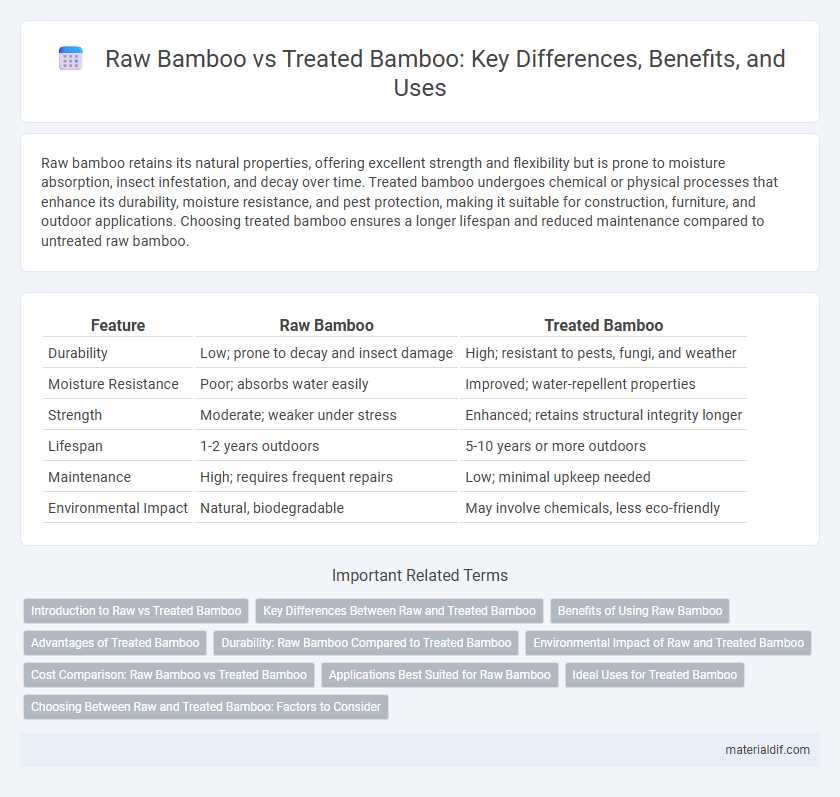Raw bamboo retains its natural properties, offering excellent strength and flexibility but is prone to moisture absorption, insect infestation, and decay over time. Treated bamboo undergoes chemical or physical processes that enhance its durability, moisture resistance, and pest protection, making it suitable for construction, furniture, and outdoor applications. Choosing treated bamboo ensures a longer lifespan and reduced maintenance compared to untreated raw bamboo.
Table of Comparison
| Feature | Raw Bamboo | Treated Bamboo |
|---|---|---|
| Durability | Low; prone to decay and insect damage | High; resistant to pests, fungi, and weather |
| Moisture Resistance | Poor; absorbs water easily | Improved; water-repellent properties |
| Strength | Moderate; weaker under stress | Enhanced; retains structural integrity longer |
| Lifespan | 1-2 years outdoors | 5-10 years or more outdoors |
| Maintenance | High; requires frequent repairs | Low; minimal upkeep needed |
| Environmental Impact | Natural, biodegradable | May involve chemicals, less eco-friendly |
Introduction to Raw vs Treated Bamboo
Raw bamboo consists of freshly harvested stalks that maintain natural moisture, making them prone to pests, mold, and degradation over time. Treated bamboo undergoes processes such as drying, boiling, or chemical treatment to enhance durability, resistance to insects, and dimensional stability. Understanding the differences between raw and treated bamboo is crucial for construction, furniture making, and sustainable material applications.
Key Differences Between Raw and Treated Bamboo
Raw bamboo retains its natural properties, including moisture content and susceptibility to pests and decay, making it prone to cracking and rotting over time. Treated bamboo undergoes processes such as chemical preservation and heat treatment to enhance durability, resistance to insects, mold, and moisture, significantly extending its lifespan. The treatment methods improve structural stability and reduce maintenance needs, making treated bamboo ideal for construction and outdoor applications.
Benefits of Using Raw Bamboo
Raw bamboo offers superior environmental benefits due to its natural biodegradability and minimal processing requirements, which reduce carbon emissions and waste production. It retains maximum strength and flexibility, making it ideal for sustainable construction, furniture, and handicrafts while maintaining its natural aesthetics. Using raw bamboo supports ecological balance by avoiding chemical treatments that can harm soil and water quality.
Advantages of Treated Bamboo
Treated bamboo significantly enhances durability and resistance against pests, mold, and moisture compared to raw bamboo, making it ideal for outdoor construction and furniture. The treatment process also improves dimensional stability and prevents cracking and warping, extending the lifespan of bamboo products. Furthermore, treated bamboo maintains its natural aesthetic while providing superior performance in various environmental conditions.
Durability: Raw Bamboo Compared to Treated Bamboo
Raw bamboo is highly susceptible to decay, insect infestation, and fungal attacks due to its natural moisture and nutrient content. Treated bamboo undergoes processes such as chemical preservation, heat treatment, or carbonization to significantly enhance resistance against rot, pests, and environmental stressors, thereby extending its lifespan. The durability of treated bamboo can be increased up to 5-10 times compared to untreated raw bamboo, making it a more reliable material for construction and outdoor applications.
Environmental Impact of Raw and Treated Bamboo
Raw bamboo has a minimal environmental footprint, as it is biodegradable, requires no chemical processing, and sequesters significant amounts of carbon dioxide during growth. Treated bamboo, while more durable and resistant to pests and decay, often involves chemical preservatives that can introduce toxins to soil and water systems, potentially harming ecosystems. Choosing raw bamboo supports sustainable practices by reducing pollution and maintaining natural biodegradability, whereas treated bamboo requires careful consideration of the environmental trade-offs associated with its chemical treatments.
Cost Comparison: Raw Bamboo vs Treated Bamboo
Raw bamboo typically costs less upfront, ranging from $0.50 to $2 per linear foot, due to minimal processing requirements. Treated bamboo, involving chemical or heat treatments to enhance durability and pest resistance, often costs between $3 and $7 per linear foot, reflecting the added manufacturing steps. The price difference is justified by the extended lifespan and reduced maintenance of treated bamboo in construction and outdoor applications.
Applications Best Suited for Raw Bamboo
Raw bamboo retains its natural strength and flexibility, making it ideal for traditional construction, scaffolding, and handicrafts where organic aesthetics are valued. Its untreated surface allows for easy customization and breathability, suitable for garden structures, fencing, and decorative elements that benefit from natural aging. Raw bamboo's eco-friendliness and biodegradability also support sustainable projects and temporary installations.
Ideal Uses for Treated Bamboo
Treated bamboo is ideal for outdoor construction projects, garden fencing, and furniture due to its enhanced resistance to moisture, insects, and decay compared to raw bamboo. Chemical or heat treatments prolong its durability, making it suitable for environments exposed to weather elements. This durability ensures treated bamboo maintains structural integrity and aesthetic appeal for extended periods in demanding applications.
Choosing Between Raw and Treated Bamboo: Factors to Consider
Choosing between raw and treated bamboo depends on factors such as durability, resistance to pests, and intended application. Raw bamboo offers a natural aesthetic but is more prone to insect infestation and weather damage, while treated bamboo undergoes processes like chemical or heat treatment to enhance strength and longevity. Consider the environment, maintenance requirements, and project lifespan to select the best option for construction, furniture, or decorative use.
Raw bamboo vs treated bamboo Infographic

 materialdif.com
materialdif.com